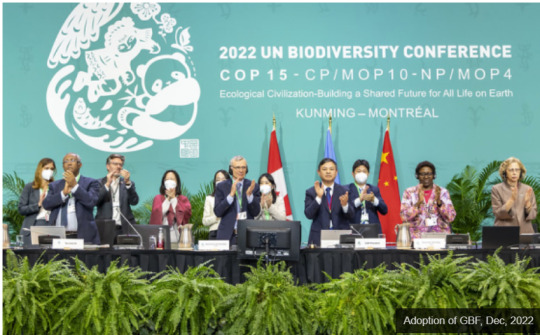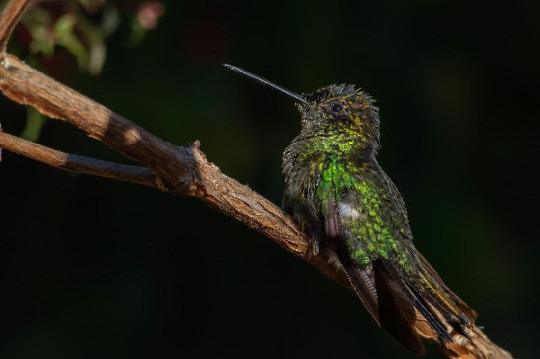#COP15
Text
Nature at risk of breakdown if Cop15 pledges not met, world leaders warned
8 notes
·
View notes
Text
A follow-up to the big biodiversity deal that was inked before Christmas
To me the most impressive things (well, all the points mentioned below matter, but these genuinely raised my eyebrows in surprise) are the fact that 30 by 30 was actually agreed to, as it's necessary but still ambitious when it comes down to it, and the centering and acknowledgement of indigenous people, who are all too often marginalized or tokenized.
The main thing is, of couse, will it be properly implemented. It's hard enough to get this sort of thing honored when one nation ostensibly agrees to it, but all these nations combined?
Agreement to conserve 30% of Earth by the end of the decade
Inspired by the Harvard biologist EO Wilson’s vision of protecting half the planet for the long-term survival of humanity, the most high-profile target at Cop15 has inspired and divided in equal measure. The final wording commits governments to conserving nearly a third of Earth for nature by 2030 while respecting indigenous and traditional territories in the expansion of new protected areas. The language emphasises the importance of effective conservation management to ensure wetlands, rainforests, grasslands and coral reefs are properly protected, not just on paper.
Indigenous rights at the heart of conservation
Indigenous peoples are mentioned 18 times in this decade’s targets to halt and reverse biodiversity, something to which activists are pointing as a historic victory. Several scientific studies have shown that Indigenous peoples are the best stewards of nature, representing 5% of humanity but protecting 80% of Earth’s biodiversity. From Brazil to the Philippines, Indigenous peoples are subjected to human rights abuses, violence and land grabs. The language in the text is clear: Indigenous-led conservation models must become the norm this decade if we are to take real action on biodiversity.
Reform of environmentally harmful subsidies
Definitely in the category of boring-but-important, the world spends at least $1.8tn (£1.3tn) every year on government subsidies driving the annihilation of wildlife and a rise in global heating, according to a study earlier this year. The lack of reform on environmentally harmful subsidies was a major failure of last decade’s biodiversity targets, and governments have now agreed on the importance of making a change.
Nature disclosures for businesses
Although the language was watered down in the final text, target 15 of the deal requires governments to ensure that large and transnational companies disclose “their risks, dependencies and impacts on biodiversity”. If implemented, this could be the start of a significant change in business practices. About half of global GDP is dependent on the healthy functioning of the natural world, according to the UN, and biodiversity loss is rapidly shooting up the agenda of corporate risks. Several countries are already developing rules for sustainable sourcing, on products from palm oil to rubber, which look set to spread after the Kunming-Montreal pact.
A way forward on digital biopiracy
Ahead of Cop15, digital sequence information (DSI) was the controversial hot potato – and something few really understood. DSI refers to digitised genetic information that we get from nature, which is used frequently to produce new drugs, vaccines and food products. These digital forms of biodiversity come from rainforests, peatlands, coral reefs and other rich ecosystems, but they are hard to trace back to their origin country, with many in the developing world now expecting payment for the use of their resources. In Montreal, an agreement was struck to develop a funding mechanism on DSI in the coming years, which has been hailed as a historic victory for African states who called for its creation before the summit.
32 notes
·
View notes
Text
"However, it was met with scepticism by some. “It’s obviously welcome that the UK starts to think about putting money on the table, but we all know this is nothing like what’s needed – either to address the nature crisis or to unlock the diplomatic process,” said Craig Bennett, CEO of Wildlife Trusts, who is at Cop15."
#animal extinction#endangered species#biodiversity#cop15#jail climate criminals#we want climate action now#climate criminals#climate crisis#climate change#klimawandel#klimakatastrophe#qihou bianhua#changement climatique#cambio climático
12 notes
·
View notes
Link
10 notes
·
View notes
Text
2022 United Nations Biodiversity Conference (COP15) - Why COP15 is Important
The 2022 United Nations Biodiversity Conference will be held from 7-19 December 2022, in Canada. The Convention on Biological Diversity (CBD) was planned first in April 2022 in China, but it was postponed, for 4 times. The Conference was originally scheduled for October 2020, but was delayed due to Covid-19. In June 2022, U.N. Secretariat said that it will be held in December 2022 in Montreal, Canada, also China’s environment ministry said in a separate statement.
9 notes
·
View notes
Text
youtube
Here’s how COP15 hopes to preserve and restore biodiversity lost across the world due to climate change
#Earth #Environment #ClimateCrisis #NowThis
#now this earth#now this#solarpunk#cop15#ecosystem#biodiversity cop#biodiversity#environment#climate crisis#climate change#climate chaos#global warming#global heating#Youtube
3 notes
·
View notes
Text
if you're in Quebec, Canada there are manifestations against the cop-15
lets stop corporations from privatising biodiversity and from exploiting native lands
there is more information in here
its in french and english
https://www.fucklacop15.org/home2

1 note
·
View note
Text
Pour un Plan Nature 2030 à la hauteur des attentes
Le CREDD Saguenay–Lac-Saint-Jean organise le « Rendez-vous de la biodiversité »
Continue reading Untitled

View On WordPress
#conseil#cop15#credd#développement#durable#environnement#lac-saint-Jean#manchette#plan nature 2030#régional#saguenay
0 notes
Text
COP15: el planeta nos necesita

COP15 y cómo está convirtiendo señalando la nueva urgencia: los gobiernos y las empresas pueden hacer para restaurar el capital natural.
Los daños al planeta por parte de las acciones humanas y riesgos que tienen como impacto relacionados con la naturaleza son significativos, pero rara vez reciben la atención que merecen.
En la 15ª COP de Biodiversidad de la ONU, decenas de miles de líderes y representantes se alinearon en objetivos claros.
Objetivos claros
La Conferencia de Biodiversidad de la ONU (COP15) de este año fue más grande que nunca.
Celebrado en Montreal en diciembre, el evento acogió a casi 20 000 líderes y representantes, un aumento significativo de los 3800 participantes en la edición anterior de 2018.
Más de 1000 empresas estuvieron representadas en comparación con sólo unas docenas en las COP de biodiversidad anteriores.
La diversidad de asistentes a la COP15 fomenta un diálogo más profundo y la transparencia entre todos los actores que deben involucrarse en la restauración del capital natural y las condiciones para que eso suceda.
La agenda se centró en cómo proteger el capital natural y limitar la pérdida de biodiversidad en todo el mundo, y la atención que recibió la reunión destacó el creciente reconocimiento de que el estado de la naturaleza es ahora una causa de preocupación generalizada e inmediata.
Entre las cuestiones clave debatidas en Montreal estuvo el alcance de los desafíos que enfrentan los ecosistemas terrestres y marinos. Los participantes examinaron métodos para proteger y restaurar estos ecosistemas con un enfoque especial en la mitigación de pérdidas y modelos financieros para lograr los objetivos de protección y restauración.
Una nueva investigación de McKinsey and Company que se publicó coincidiendo con la COP15 hace un primer intento cuantificado de abordar cómo las empresas pueden participar.
Adoptar un enfoque de múltiples partes interesadas para restaurar el capital natural
El informe, Naturaleza en el equilibrio: Qué pueden hacer las empresas para restaurar el capital natural, busca calcular el impacto de la actividad humana en el capital natural.
Sus hallazgos están lejos de ser fatalistas: el informe sugiere que, si bien una variedad de sectores económicos contribuyen al agotamiento del capital natural (principalmente la agricultura, pero también las ventas minoristas y los servicios y el sector energético), las acciones específicas de las empresas que utilizan las tecnologías actuales podrían no solo revertir la tendencia, sino que también generan un retorno positivo de la inversión en un número considerable de casos.
El informe es la última investigación de McKinsey para abordar el capital natural y se centra en las acciones corporativas al tiempo que menciona los habilitadores de políticas. En junio de 2022, publicamos una evaluación cuantitativa de la naturaleza y el riesgo para las instituciones financieras en África.
Y nuestro informe de septiembre de 2020 sobre Valoración de la conservación de la naturaleza estimó que la acción sobre la naturaleza podría respaldar alrededor de 30 millones de empleos y $500 mil millones del PIB en ecoturismo y pesca y beneficiar particularmente a lugares remotos. y comunidades vulnerables.
Nuestro análisis muestra que, para ser efectivas y eficientes, las acciones corporativas deberían estar acompañadas por el apoyo de otros actores tanto del sector público como del social.
El imperativo comercial para invertir en la naturaleza
Mitigar el riesgo climático es imposible sin invertir en la naturaleza, pero a diferencia del riesgo climático, que ha sido estudiado durante las últimas dos décadas y ha dado lugar a un marco de objetivos globales, objetivos corporativos y guías de acción, métricas y contabilidad, y monedas globales emergentes, las preguntas básicas sobre la naturaleza quedan sin respuesta.
El riesgo relacionado con la naturaleza no tiene una unidad única de comparación y no existe un objetivo único para preservar el capital natural, como limitar el calentamiento global a 1,5 °C.
Como resultado, los compromisos corporativos relacionados con la naturaleza han sido en gran medida oportunistas en lugar de basarse en la estrategia, la huella o los objetivos globales.
Los resultados de la COP15 tienen varias implicaciones para las empresas. El 19 de diciembre, el Marco Global de Biodiversidad de Kunming-Montreal fue adoptado como el principal resultado de la COP15, proporcionando objetivos claros.
Estos incluyen, para 2030, proteger al menos el 30 por ciento de las áreas terrestres, de aguas continentales y costeras y marinas y garantizar que al menos el 30 por ciento de las áreas degradadas estén bajo restauración efectiva.
Lograr estos objetivos casi duplicaría la cantidad de tierra y aguas nacionales conservadas, lo que puede afectar las operaciones comerciales que dependen de los recursos naturales, actuales y futuros.
Otros objetivos también tienen importantes implicaciones comerciales y financieras.
El objetivo 15 del acuerdo, por ejemplo, tiene como objetivo alentar y permitir que las empresas monitoreen sus riesgos, dependencias e impactos en la biodiversidad y puede traducirse en regulaciones nacionales de informes.
Y Target 19 tiene como objetivo movilizar $200 mil millones por año para 2030 (se adoptó una meta similar para el clima en 2009 en Copenhague). Esto supone que se activará la financiación privada y se incentivará al sector privado para invertir en la biodiversidad.
El camino a seguir
McKinsey aspira a ser un catalizador en dos áreas: ayudar a las empresas a diseñar e implementar transformaciones positivas para la naturaleza y guiar a los gobiernos sobre cómo diseñar e implementar de manera óptima sus objetivos 30×30.
Por ejemplo, se está trabajando con Blue Nature Alliance, que tiene como objetivo promover la conservación de los océanos a gran escala, y con Endwhile Earth, que tiene como objetivo acelerar la conservación de los océanos, la tierra y el agua dulce, y apoyar el desarrollo comunitario en todo el mundo.
2023 será un año crucial para progresar, y las empresas, los gobiernos y las organizaciones no gubernamentales por igual tienen un papel importante que desempeñar.
Los líderes corporativos deben comprender la magnitud del desafío que se avecina, los riesgos que podría plantear la pérdida de capital natural y las oportunidades para la construcción de negocios más sostenibles, así como las implicaciones del Marco de Biodiversidad Global Kunming-Montreal recientemente adoptado para su empresa.
Hemos pasado el momento en que la inacción es aceptable.
Los esfuerzos que las empresas han realizado sobre la acción climática y las lecciones que han aprendido podrían aprovechar los esfuerzos de descarbonización existentes para ayudar a preservar el capital natural y la Tierra tal como la conocemos.
Originally published at http://accionbiodiversidadblog.com/ April 22, 2023.
0 notes
Text
Reach the global vision of a world living in harmony with nature by 2050.

The Kunming-Montreal Global Biodiversity Framework (GBF) was adopted during the fifteenth meeting of the Conference of the Parties (COP 15) following a four year consultation and negotiation process. This historic Framework, which supports the achievement of the Sustainable Development Goals and builds on the Convention’s previous Strategic Plans, sets out an ambitious pathway to reach the global vision of a world living in harmony with nature by 2050. Among the Framework’s key elements are 4 goals for 2050 and 23 targets for 2030.
The implementation of the Kunming-Montreal Global Biodiversity Framework will be guided and supported through a comprehensive package of decisions also adopted at COP 15. This package includes a monitoring framework for the GBF, an enhanced mechanism for planning, monitoring, reporting and reviewing implementation, the necessary financial resources for implementation, strategic frameworks for capacity development and technical and scientific cooperation, as well as an agreement on digital sequence information on genetic resources.
In adopting the Kunming-Montreal Global Biodiversity Framework, all Parties committed to setting national targets to implement it, while all other actors have been invited to develop and communicate their own commitments. At the next meeting of the Conference of the Parties in 2024 in Türkiye, the world will take stock of the targets and commitments that have been set.
To download the official text of the Kunming-Montreal Global Biodiversity Framework see decision 15/4.
#Kunming-Montreal Global Biodiversity Framework#cop15#genetic resources#capacity development#technical cooperation#Scientific Cooperation#Sustainable Development Goals
0 notes
Text
More than 650 scientists are urging world leaders to stop burning trees to make energy because it destroys valuable habitats for wildlife.
In the buildup to Cop15, the UN biodiversity summit, they say countries urgently need to stop using forest bioenergy to create heat and electricity as it undermines international climate and nature targets. Instead, renewable energy sources such as wind and solar should be used, they say.
Bioenergy has “wrongly been deemed ‘carbon neutral’” and many countries are increasingly relying on forest biomass to meet net zero goals, according to the letter, addressed to world leaders including Joe Biden, Rishi Sunak and the European Commission president, Ursula von der Leyen. “The best thing for the climate and biodiversity is to leave forests standing – and biomass energy does the opposite,” it says.
The letter says that if global leaders agree to protect 30% of land and sea by 2030 at the Cop15 meeting in Montreal, they must also commit to ending reliance on biomass energy. Commitments made at Cop15 and at climate conferences could be undermined if this practice continues, it says.
13 notes
·
View notes
Text
UN Targets 20 Million Green Jobs Through Nature-Based Solutions
Twenty million jobs could be created worldwide through the power of nature, which could potentially address significant societal and environmental issues such as climate change, disaster risk, and food and water insecurity, as announced during the United Nation’s Biodiversity Conference, COP15, in Montreal.
(more…) “”

View On WordPress
0 notes
Text

L'été 2022 a été le plus #sec enregistré en #France depuis le début des mesures, selon une source aride, qui n'a pas pu nous en dire plus !
Lisez l'article sur bit.ly/3IQjlRd
#canicule#sécheresse#neige#ecologie#science#humour#sobriété#climat#COP15#froid#réchauffementclimatique#météo#pluie#gérard#tempête#cyclone#ouragan
0 notes
Text
Lo bueno, lo malo y lo feo: un pacto histórico por la biodiversidad
◽️La 15. a Conferencia de las Partes del Convenio de las Naciones Unidas sobre Biodiversidad se llevó a cabo en Montreal del 7 al 19 de diciembre de 2022. Los resultados fueron mixtos. Este artículo analiza lo bueno, lo malo, lo feo, así como el camino a seguir desde la COP15 de la CDB.
Por Simone Lovera*
16 de enero, 2023.- Fue un acontecimiento incómodo: justo en el momento en que el ministro…

View On WordPress
0 notes
